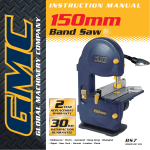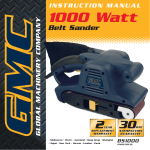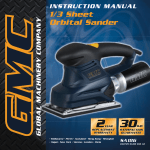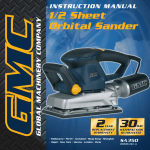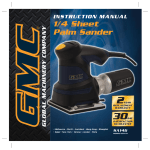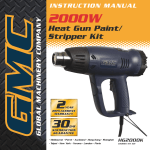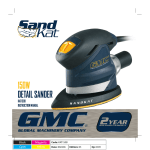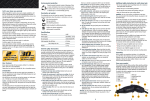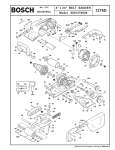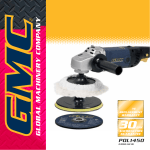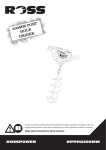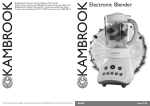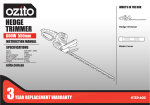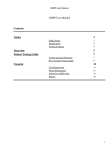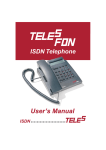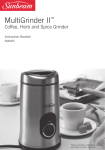Download Global Machinery Company KAT150A User's Manual
Transcript
INSTRUCTION MANUAL 125W Detail Sander • Melbourne • Perth • Auckland • Hong Kong • Shanghai • Taipei • New York • Verona • London • Paris KAT150A 031223 ED4 DR Contents Warranty Introduction Description of symbols Specifications General safety instructions Additional safety rules for sanders Accessories Know your product Unpacking Assembly Operation Turning your sander on Fitting sandpaper Sanding Cleaning General inspection Power cord maintenance 2 3 3 3 4 5 6 7 7 7 8 8 8 8 9 9 9 Full 2 Years Home Use Warranty Whilst every effort is made to ensure your complete satisfaction with this tool, occasionally, due to the mass manufacturing techniques, a tool may not live up to our required level of performance and you may need the assistance of our service department. This product is warranted for a 2-year period for home domestic use from the date of the original purchase. If found to be defective in materials or workmanship, the tool or the offending faulty component will be replaced free of charge with another of the same item. A small freight charge may apply. The warranty replacement unit is only made available by returning the tool to the place of purchase with a confirmed register receipt. Proof of purchase is essential. We reserve the right to reject any claim where the purchase cannot be verified. This warranty does not include damage or defects to the tool caused by or resulting from abuse, accidents, alterations or commercial or business use. It also does not cover any bonus accessories unless the tool is a GMC Platinum Professional model. Please ensure that you store your receipt in a safe place. Conditions apply to the above warranty. If you need direction of what constitutes a free of charge warranty claim, please review the guide given on the rear of the Receipt Holder. An indication is given as to the types of claim that are permissible, and those that are not. Symbols Dear Customer The rating plate on your tool may show symbols. These represent important information about the product or instructions on its use. Wear hearing protection. Wear eye protection. Wear breathing protection. If you require any help with your product, whether it is a Warranty claim, spare part or user information, please phone our Help Line for an immediate response. Phone 1300 880 001 in Australia or 0800 445 721 in New Zealand. Introduction Double insulated for additional protection. Your new GMC power tool will more than satisfy your expectations. It has been manufactured under stringent GMC Quality Standards to meet superior performance criteria. You will find your new tool easy and safe to operate, and, with proper care, it will give you many years of dependable service. Caution. Carefully read through this entire Instruction Manual before using your new GMC Power Tool. Take special care to heed the Cautions and Warnings. Your GMC power tool has many features that will make your job faster and easier. Safety, performance, and dependability have been given top priority in the development of this tool, making it easy to maintain and operate. Conforms to relevant safety standards. Specifications Voltage: 230 to 240V~ 50Hz Input power: 125W Idle speed (no load): 13000 OPM Weight: 0.85kg Length of cordset: 3m Base area: iron base shape 140mm x 100mm Paper type: Hook & Loop Insulation type: II, double insulated Replacement sandpaper can be purchased through your local GMC dealer. Environmental protection Recycle unwanted materials instead of disposing of them as waste. All tools, hoses and packaging should be sorted, taken to the local recycling centre and disposed of in an environmentally safe way. 3 General safety instructions 10. Secure the work piece. Use clamps or a vice to hold the work piece. It is safer than using your hand and frees both hands to operate the tool. 11. Do not overreach. Keep your footing secure and balanced at all times. 12. Look after your tools. Keep tools sharp and clean for better and safer performance. Follow the instructions regarding lubrication and accessory changes. Inspect tool cords periodically and, if damaged, have them repaired by an authorised service facility. Inspect extension cords periodically and replace them if damaged. Keep tool handles dry, clean and free from oil and grease. 13. Disconnect idle tools. Switch off the power and disconnect the plug from the power point before servicing, when changing accessories and when the tool is not in use. 14. Remove adjusting keys and wrenches. Check to see that keys and adjusting wrenches are removed from the tool before switching on. 15. Avoid unintentional starting. Always check that the switch is in the OFF position before plugging in the tool to the power supply. Do not carry a plugged in tool with your finger on the switch. 16. Use outdoor rated extension cords. When a tool is used outdoors, use only extension cords that are intended for outdoor use and are so marked. 17. Stay alert. Watch what you are doing. Use common sense. Do not operate a power tool when you are tired. 18. Check for damaged parts. Before using a tool, check that there are no damaged parts. If a part is slightly damaged, carefully determine if it will operate properly and perform its intended function. Check for alignment of moving parts, binding of moving parts, breakage of parts, proper mounting and any other conditions that may affect the operation of the tool. A part that is damaged should be properly repaired Warning. When using power tools, basic safety precautions should always be taken to reduce the risk of fire, electric shock and personal injury. Also, please read and heed the advice given in the additional important safety instructions. 1. Keep the work area clean and tidy. Cluttered work areas and benches invite accidents and injury. 2. Consider the environment in which you are working. Do not use power tools in damp or wet locations. Keep the work area well lit. Do not expose power tools to rain. Do not use power tools in the presence of flammable liquids or gases. 3. Keep visitors away from the work area. All visitors and onlookers, especially children and infirm persons, should be kept well away from where you are working. Do not let others in the vicinity make contact with the tool or extension cord. 4. Store tools safely. When not in use, tools should be locked up out of reach. 5. Do not force the tool. The tool will do the job better and safer working at the rate for which it was designed. 6. Use the correct tool for the job. Do not force small tools or attachments to do the job best handled by a heavier duty tool. Never use a tool for a purpose for which it was not intended. 7. Dress correctly. Do not wear loose clothing or jewellery. They can be caught in moving parts. Rubber gloves and non-slip footwear are recommended when working outdoors. If you have long hair, wear a protective hair covering. 8. Use safety accessories. Safety glasses and earmuffs should always be worn. A face or dust mask is also required if the drilling operation creates dust. 9. Do not abuse the power cord. Never pull the cord to disconnect the tool from the power point. Keep the cord away from heat, oil and sharp edges. 4 or replaced by an authorised service facility, unless otherwise indicated in this Instruction Manual. Defective switches must be replaced by an authorised service facility. Do not use a tool if the switch does not turn the tool on and off correctly. 19. Guard against electric shock. Prevent body contact with grounded objects such as water pipes, radiators, cookers and refrigerator enclosures. 20. Use only approved parts. When servicing, use only identical replacement parts. Use an authorised service facility to fit replacement parts. Warning. The use of an accessory or attachment, other than those recommended in this Instruction Manual, may present a risk of personal injury. sandpaper. • Rags, cloths, cord, string and the like should never be left around the work area. • Do not continue to use worn, torn or heavily clogged sanding sheets. • Do not touch the moving sanding sheet. Ensure that you have removed foreign objects such as nails and screrws from the work before commencing sanding. WARNING. Before connecting a tool to a power source (mains switch power point receptacle, outlet, etc.) be sure that the voltage supply is the same as that specified on the nameplate of the tool. A power source with a voltage greater than that specified for the tool can result in serious injury to the user, as well as damage to the tool. If in doubt, do not plug in the tool. Using a power source with a voltage less than the nameplate rating is harmful to the motor. The tool must be used only for its prescribed purpose. Any use other than those mentioned in this Manual will be considered a case of misuse. The user and not the manufacturer shall be liable for any damage or injury resulting from such cases of misuse. To use this tool properly, you must observe the safety regulations, the assembly instructions and the operating instructions to be found in this Manual. All persons who use and service the machine have to be acquainted with this Manual and must be informed about its potential hazards. Children and infirm people must not use this tool. Children should be supervised at all times if they are in the area in which the tool is being used. It is also imperative that you observe the accident prevention regulations in force in your area. The same applies for general rules of occupational health and safety. The manufacturer shall not be liable for any changes made to the tool nor for any damage resulting from such changes. Even when the tool is used as prescribed it is not possible to Additional safety rules for sanders. Warning. Remove the plug from the power socket before carrying out any adjustment, servicing or maintenance, including the changing of sandpaper. • When fitting and changing sandpaper, always follow the instructions. • If possible, always use clamps or a vice to hold your work. • Make sure that the switch is off before you plug the tool in. • Do not over-reach, be sure of your footing and balance at all times. • Always wear eye and ear protection and use a dust mask. • Only use good quality sandpaper. • Do not force the sander; let the tool do the work at a reasonable feed speed. Overloading will occur if too much pressure is applied and the motor slows resulting in inefficient sanding and possible damage to the sander motor. • Always switch off before you put the sander down. • Disconnect the sander from the power supply when it is not in use, before cleaning and when changing 5 eliminate all residual risk factors. The following hazards may arise in connection with the tool’s construction and design: • Damage to the lungs if an effective dust mask is not worn. • Damage to hearing if effective earmuffs are not worn. • Always remove the plug from the mains socket before making any adjustments or maintenance, including changing the sandpaper. Accessories The GMC KAT150A Sand Kat Sander is supplied with the following accessories as standard: • Dust extraction adaptor • 4 x 60 grade sandpaper sheets • 4 x 120 grade sandpaper sheets • 2 x 240 grade sandpaper sheets • Storage case • This instruction manual Wear goggles Wear earmuffs Wear a breathing mask 6 Know your product Unpacking The sander is designed for sanding wood, metal, plastic and similar materials. It is a finishing sander and should be used only when giving a surface a final sanding. As the base is reasonably small, the sander is suited for accessing tight corners that larger sanders are unable to reach. 1. On/Off switch 2. Palm-grip handle 3. Platen 4. Dust extraction port Due to modern mass production techniques, it is unlikely that your GMC Power Tool is faulty or that a part is missing. If you find anything wrong, do not operate the tool until the parts have been replaced or the fault has been rectified. Failure to do so could result in serious personal injury. Assembly The GMC KAT150A Sand Kat Detail Sander is packed, fully assembled, ready for use. You need only to add the appropriate sanding sheet. 2 1 4 3 7 Operation Coarse, Medium and Fine. 2. Use a coarse grit to sand down rough finishes, medium grit to smooth the work and fine grit to finish off. 3. It is best to make a trial run on a scrap piece of material to determine the optimum grades of sandpaper for a particular job. Warning. Do not use the same sanding sheet for wood and metal. Metal particles become embedded in the sandpaper and will scour a wooden surface. Warning. Take care to regularly clean out the build up of dust on the platen underneath the sandpaper and not let the sandpaper wear completely down before replacing it. Failure to observe these two precautionary measures can lead to damage to the platen. Turning your sander on 1. With the cordset fitted to a power outlet, switch the sander on by pressing the “I” mark on the protective cover of the switch. 2. To turn off the sander, press the “O” mark on the protective cover of the switch. Note. It takes a few operations to get used to switching the sander on and off due to the protective cover. However, it is well worth the effort due to the protection afforded to the switch and the consequent increased lifetime of the unit. Sanding 1. The sander can be used for most sanding operations on materials such as wood, plastic, metal and painted surfaces. 2. Wear safety goggles a dust mask and ear muffs. 3. Switch the sander on whilst it is resting on the workpiece. Take care to hold the whole area of the platen on the work. 4. Move the sander over the surface of the work in a circular motion with an even, moderate pressure. Caution. Where possible, clamp smaller workpieces to the bench. Note. If there are still scratches on your work after sanding, try either of the following: 1. go back to a coarser grit and sand the marks out before recommencing with the original choice or, 2. try using new sandpaper of the same grit to eliminate the unwanted marks before progressing to a finer grit and finishing the job. Fitting sandpaper 1. Disconnect the sander from the power supply. 2. Remove any dust or debris from the hooks and loops of the platen. 3. Align the sandpaper holes with the platen and press it firmly in place to ensure a good attachment. Caution. Take care to regularly clean out the build up of dust on the platen underneath the sandpaper and not to let the sandpaper wear completely down before replacing it. Failure to observe these two precautionary measures can lead to damage to the hooks and loops on the platen and the sandpaper will not attach properly. If the platen is damaged, it can be replaced at an authorised service centre. Note. Hook and loop platens are not a warranty item. Selecting the right grade of sandpaper for the job 1. Different grades of sanding paper can be purchased from your local hardware store. Available grades are: 8 Cleaning Maintenance 1. Keep the tool’s air vents unclogged and clean at all times. 2. Remove dust and dirt regularly. Cleaning is best done with a rag. 3. Never use caustic agents to clean plastic parts. CAUTION. Do not use cleaning agents to clean the plastic parts of the sander. A mild detergent on a damp cloth is recommended. Water must never come into contact with the sander. All the bearings are sealed ball bearings, lubricated for life, and require no maintenance. General inspection Regularly check that all the fixing screws are tight. They may vibrate loose over time. Power cord maintenance If the supply cord needs replacing, the task must be carried out by the manufacturer, the manufacturer’s agent, or an authorised service centre in order to avoid a safety hazard. 9 Carefully read the entire Instruction Manual before using this product. Before returning this product for a Warranty Claim or any other reason Please Call 1300 880 001 (Australia) or 0800 445 721 (New Zealand) When you make your call, please have the following information at hand: With continuing product development changes may have occurred which render the product received slightly different to that shown in this instruction manual. The manufacturer reserves the right to change specifications without notice. Note: Specifications may differ from country to country. • GMC Product Type • GMC Product Code A GMC Service Engineer will take your call and, in most cases, will be able to solve your problem over the phone. You are welcome to use this phone-in service to make suggestions or give comments about any GMC product. 45–55 South Centre Road Melbourne Airport Victoria, Australia 3045 Tel: (03) 8346 1100 Fax: (03) 8346 1200 The GMC 777 Helpline operates from 7am to 7pm, 7 days a week (EST). This allows you to contact GMC directly with any queries and technical questions you have regarding our products. Save this Manual for future reference.










